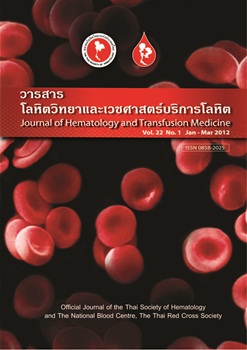ปัจจัยที่มีผลต่อการเกิดสารต้านในผู้ป่วยเด็กไทยโรคฮีโมฟีเลีย เอ ชนิดรุนแรงมาก
Keywords:
โรคฮีโมฟีเลีย เอ ชนิดรุนแรงมาก, สารต้าน, Intron 22 inversion, ปัจจัยเสี่ยง, Severe hemophilia A, Inhibitor, Risk factorAbstract
วัตถุประสงค์ : เพื่อศึกษาปัจจัยที่มีอิทธิพลต่อการเกิดสารต้านในผู้ป่วยเด็กไทยโรคฮีโมฟีเลีย เอ ชนิดรุนแรงมาก วิธีการ : คัดเลือกผู้ป่วยโรคฮีโมฟีเลีย เอ ชนิดรุนแรงมากที่ติดตามการรักษาอยู่ที่หน่วยโลหิตวิทยาและมะเร็งในเด็ก คณะแพทยศาสตร์โรงพยาบาลรามาธิบดี มหาวิทยาลัยมหิดล จำนวน 35 คน โดยผู้ป่วยจะได้รับการตรวจวัดหาระดับสารต้านทุก 6-12 เดือน และตรวจหาความผิดปกติของยีนแฟคเตอร์แปดชนิด intron 22 inversion รวมทั้งได้รวบรวมข้อมูลเกี่ยวกับอายุที่เริ่มรับการรักษา ชนิดของแฟคเตอร์ที่ได้รับการทดแทน ผลิตภัณฑ์จากเลือดชนิดต่างๆที่ได้รับในการรักษาเมื่อเวลามีเลือดออก วิธีการรักษา ระยะเวลาที่ได้รับปัจจัยเหล่านั้นรวมทั้งประวัติการมีสารต้านในครอบครัว ผลการศึกษา : ผู้ป่วยโรคฮีโมฟีเลีย เอ ชนิดรุนแรงมากจำนวน 10 คนใน 35 คน พบว่ามีสารต้านและในจำนวนนี้มีถึง 4 คนที่มีระดับสารต้านในระดับสูง คิดเป็นร้อยละ 11.4 โดยมีอายุเฉลี่ยอยู่ที่ 5.5 เดือน และ 9 คนในจำนวนนี้ได้รับการรักษาตั้งแต่อายุน้อยกว่า 12 เดือนซึ่งมีความแตกต่างจากกลุ่มผู้ป่วยที่ไม่มีสารต้านอย่างมีนัยสำคัญทางสถิติ (p = 0.038) ระยะเวลามัธยฐานที่ผู้ป่วยกลุ่มนี้ได้รับสารทดแทนแฟคเตอร์แปด คือ 8 วัน ซึ่งได้รับทั้งจากส่วนประกอบของเลือดและแฟคเตอร์เข้มข้น และพบว่าวิธีการรักษา treatment on demand และ/หรือ early treatment ไม่มีความสัมพันธ์กันกับการเกิดสารต้าน ส่วนความผิดปกติของสารพันธุกรรม พบว่าผู้ป่วย 15 คนคิดเป็นร้อยละ 42.9 มี intron 22 inversion และในจำนวนนี้ 6 คน(ร้อยละ 40) มีสารต้าน ซึ่งความผิดปกติของพันธุกรรมไม่มีความสัมพันธ์กันกับการเกิดสารต้าน สรุป : อุบัติการณ์ของการเกิดสารต้านในผู้ป่วยเด็กไทยโรคฮีโมฟีเลีย เอ ชนิดรุนแรงมากพบได้ถึงร้อยละ 28.6 และร้อยละ 11.4 ของผู้ป่วยกลุ่มนี้มีสารต้านในระดับสูง(> 5 Bethesda unit) ปัจจัยที่พบว่ามีความสัมพันธ์กับการเกิดสารต้านคืออายุที่เริ่มได้รับสารทดแทนแฟคเตอร์แปดน้อยกว่า 12 เดือน ไม่ว่าจะเป็นแฟคเตอร์เข้มข้นหรือส่วนประกอบของเลือด
Key Words : โรคฮีโมฟีเลีย เอ ชนิดรุนแรงมาก, สารต้าน, Intron 22 inversion, ปัจจัยเสี่ยง
Abstract
Objective : To find out the risk factors for inhibitor development in Thai children with severe hemophilia A. Methods : Thirty-five severe hemophilia A children attending the Division of Hematology-Oncology, Department of Pediatrics, Faculty of Medicine, Ramathibodi Hospital, were enrolled in the study. They were regularly assessed for inhibitor every 6 to 12 months and the specific mutation of intron 22 inversion was determined by inverse shifting-polymerase chain reaction. Other non-genetic factors, such as the age at start treatment, exposure day, type of factor VIII replacement, type of treatment and family history, were reviewed for evaluating the association to inhibitor development. Result : Ten out of 35 severe hemophilia A children developed inhibitor and 4 of them had high titer. The median age of the inhibitor group was 5.5 months. Nine patients received treatment before 12 months which was significantly faster than those without inhibitors (p = 0.038). The median exposure day was 8 days for both factor concentrate and blood components. The proportion of treatment on demand and/or early treatment was not significantly different from the no-inhibitor group. Fifteen of 35 (42.8%) patients had intron 22 inversion and 6 (40%) had inhibitor. However, the occurrence of intron 22 inversion was not significantly associated with inhibitor development. Conclusion : The incidence of inhibitor in Thai children with severe hemophilia A was 28.6% and 11.4% of them had high titer. The significant risk factor for inhibitor development was the start of replacement therapy before the age of 12 months.
Key Words : Severe hemophilia A, Inhibitor, Intron 22 inversion, Risk factor



